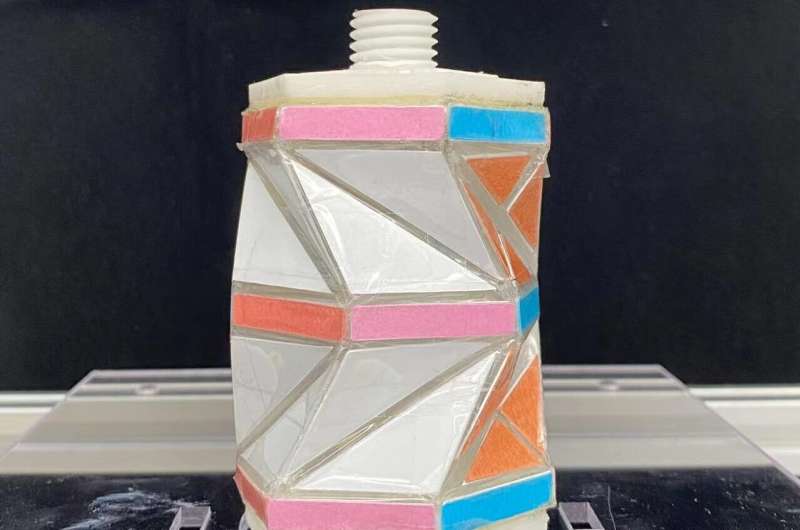August 12, 2023 feature
This article has been reviewed according to Science X's editorial process and policies. Editors have highlighted the following attributes while ensuring the content's credibility:
fact-checked
peer-reviewed publication
trusted source
proofread
An origami-inspired universally deformable module for robotics applications

Modular robots—robotic systems that can adapt their body configuration to change locomotion style or move on different terrains—can be highly advantageous for tackling missions in diverse environments. Over the past decade or so, engineers have developed a wide range of modular robots that rely on different designs and underlying mechanisms.
A research team at Westlake University and Zhejiang University in China recently introduced a new modular robot design inspired by the paper-folding art of origami, specifically by an origami fold known as the Kresling pattern. Their design, introduced in a paper in Nature Communications, relies on newly introduced, universally deformable modules that can be rearranged to create different shapes and configurations.
"There have been some efforts to use Kresling pattern to develop multimode robotic arms," Hanquing Jiang, one of the researchers who carried out the study, told Tech Xplore. "However, the existing methods are purely based the Kresling pattern itself; thus, the deformation modes are limited by the coupled twisting and contraction mode. The primary objective is to modify the classical Kresling pattern and to generate new deformation modes."
In the context of origami, the Kresling pattern consists in alternating mountain (i.e., protruding) and valley (i.e., sunken) folds angled along opposing twisting directions. This pattern can be used to create complex shapes that resemble patterns observed in nature, such as those on the wings of hawkmoth or the spiral geometries on pinecones.
As part of their study, Jiang and his colleagues tried to use this particular origami pattern to create a modular deformable unit that could be adapted to create different shapes. The module they create is driven by pneumatics, systems that rely on gas or pressurized air to produce different movements.
"The unit consists of a two-level Kresling pattern with opposite twisting directions on each level," Jiang explained. "More importantly, on each level, there are two side pouches on the opposite sides. Thus, depending on how the side pouches are pressurized, when the main chamber is vacuumed, we can achieve different deformation modes."
The new module introduced by the researchers can change its shape based on the pressure applied to it, producing all kinds of shapes that meet the needs of specific application scenarios. In total, it can produce seven different motion modes in robots with a single origami module, including three basic motions and four re-combinations of these basic movements.
"Our two-level unit is a universal deformation module that can achieve all possible deformation modes depending on the specific pressurization schemes employed," Jiang said. "The module is like our arms, which can do all deformation modes (contraction/extension, twisting, bending), depending on how the nerves control the muscles. The unit's pressurization schemes are like our nerves and the universal module takes on the role of our arm. This origami-based robotic arm would function as the rigid robotic arm that has six degrees of freedom."
The researchers evaluated their origami-inspired deformable module in a series of simulations and real-world experiments. The results they gathered were highly promising, highlighting its potential for developing modular robots that can adapt to their surrounding environment and move in different ways.
Remarkably, the module can also be reassembled while a robot is operating, making it ideal for complex real-world missions that require swift adaptations to environmental changes. In the future, this work could thus pave the way for more sophisticated soft robots that are more responsive to their surroundings.
"In my next works, I plan to utilize this structure for more practical applications, such as grasping sizable objects," Jiang added.
More information: Chao Zhang et al, Plug & play origami modules with all-purpose deformation modes, Nature Communications (2023). DOI: 10.1038/s41467-023-39980-7
© 2023 Science X Network


















